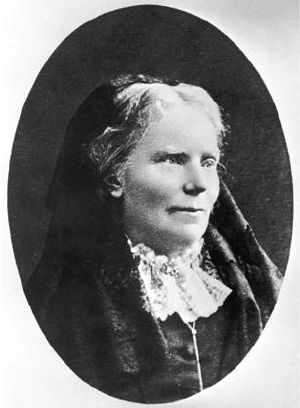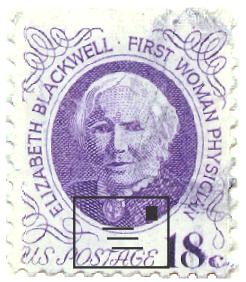Elizabeth Blackwell
Elizabeth Blackwell, February 3, 1821 - May 31, 1910, was not only an abolitionist and a women's rights activist, but the first woman in the United States to practice medicine with a college degree. She supported medical education for women and helped many other women achieve their goals. She established the New York Infirmary in 1857, thereby offering practical solutions to one of the many problems facing women who were rejected from internships elsewhere. She published several important books on the issue of women in medicine. She has become a role model for young women everywhere.
Early Life
Blackwell was born in Bristol, England, the third of nine children born to a sugar refiner who could afford to give his numerous sons, as well as his daughters, an education. In 1831, the family emigrated to the United States, and set up a refinery in New York City. After the death of her father, she took up a career in teaching. Desiring to apply herself to the practice of medicine, she took up residence in a physician's household, using her time there to study from the family's medical library. She became active in the anti-slavery movement (as did her brother Henry Brown Blackwell, who married Lucy Stone), in the course of which she made friends with Harriet Beecher Stowe. Another brother, Samuel C. Blackwell, married another important figure in women's rights, Antoinette Brown.
Blackwell applied to several prominent medical schools but was rejected by all. Her second round of applications was sent to smaller colleges, including Geneva College in New York. She was accepted there—anecdotally, because the faculty put it to a student vote, and the students thought her application a hoax—and braved the prejudice of some of the professors and students to complete her training. She persisted, ranking first in her class. On January 23, 1849, she became the first woman to earn a medical degree in the United States.
Barred from practice in most hospitals, she founded her own infirmary, the New York Infirmary for Indigent Women and Children, in 1857. When the American Civil War began, she trained nurses, and in 1868 she founded a Women's Medical College at the Infirmary to formally train women, physicians, and doctors.
In 1869 she left her sister Emily in charge of the College and returned to England. There, with Florence Nightingale, she opened the Women's Medical College. Blackwell taught at the newly-created London School of Medicine for Women and became the first female physician and doctor in the UK Medical Register. She retired at the age of 86.
Her sex education guide, The Moral Education of the Young, was published in Britain, as was her autobiography, Pioneer Work in Opening the Medical Profession to Women (1895). Upon her death, she was buried in a remote part of Scotland.
ReferencesISBN links support NWE through referral fees
- Ashby, Ruth, and Deborah Gore Ohrn. Herstory: women who changed the world. New York: Viking1995. ISBN 9780670854349
- Blackwell, Elizabeth. Pioneer work in opening the medical profession to women; autobiographical sketches. [New York]: Source Book Press 1970. ISBN 9780876810804
- Boyd, Julia. The excellent doctor Blackwell: the life of the first woman physician. Stroud, Gloucestershire: Sutton Pub 2005. ISBN 9780750941402
- Klobuchar, Lisa. Elizabeth Blackwell: with profiles of Elizabeth Garrett Anderson and Susan La Flesche Picotte. Biographical connections. Chicago: World Book2007. ISBN 9780716618263
- Leavitt, Amie Jane. Elizabeth Blackwell. Hockessin, Del: Mitchell Lane Publishers 2007. ISBN 9781584155799
External links
- An online history at the National Institutes of Health, including copies of historical documents
- An online biography of Elizabeth Blackwell, with links to more articles on Blackwell and others in her famous family, plus links to many resources on the Net
- Biography from the National Institute of Health
- Documents on Elizabeth Blackwell from the Hobart and William Smith Colleges Archives.
- Elizabeth Blackwell Resources Available in Hobart and William Smith Colleges Archives.
- Chronological Bibliography of Selected Scholarly Works by Dr. Elizabeth Blackwell.
Credits
New World Encyclopedia writers and editors rewrote and completed the Wikipedia article in accordance with New World Encyclopedia standards. This article abides by terms of the Creative Commons CC-by-sa 3.0 License (CC-by-sa), which may be used and disseminated with proper attribution. Credit is due under the terms of this license that can reference both the New World Encyclopedia contributors and the selfless volunteer contributors of the Wikimedia Foundation. To cite this article click here for a list of acceptable citing formats.The history of earlier contributions by wikipedians is accessible to researchers here:
The history of this article since it was imported to New World Encyclopedia:
Note: Some restrictions may apply to use of individual images which are separately licensed.

